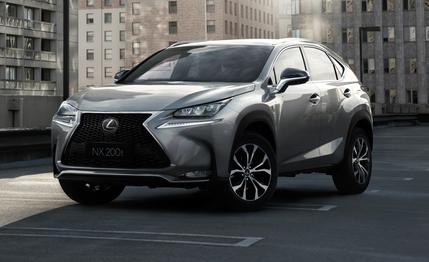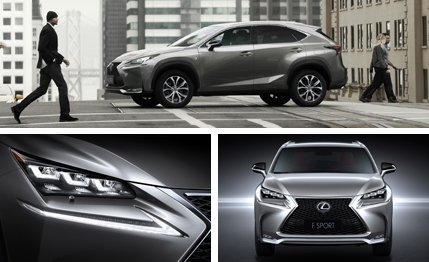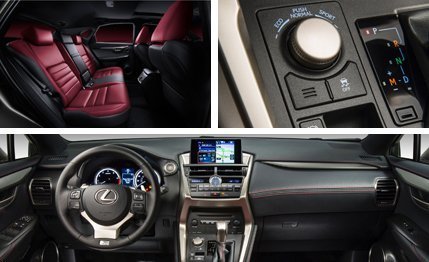
 Instrumented Test
Instrumented Test
It’s always interesting to watch a company venture into new territory, like Lexus launching this compact SUV, the NX. Sharing key dirty parts with the Toyota RAV4, the NX is available as either the soft, fuel-sipping NX300h hybrid or the NX200t, the first-ever turbocharged Lexus. After a brief first-drive experience in both, we finally got an NX300h (covered separately) and this sportified F Sport version of the NX200t into our offices for track testing. Where does the NX fit into the field of compact luxury utes that has exploded this year, a class that now includes the Audi Q3, the BMW X1, and the Mercedes-Benz GLA?
We were particularly keen to see how this twin-scroll-turbocharged 2.0-liter four-cylinder would motivate 4021 pounds of crossover. It uses two injectors per cylinder and an integrated four-into-two exhaust manifold said to reduce lag, and it mates to a new six-speed automatic transmission. The F Sport trim brings a higher-effort steering system and sport-tuned suspension aimed at elevating the NX’s handling to the level of Lexus’s performance bogeys, the Audi Q5 and BMW X3.
The numbers we got at the track won’t exactly light your hair on fire, the NX accelerating from zero to 60 mph in 6.9 seconds and hitting the quarter-mile in 15.3 seconds at 92 mph. That 60-mph time ties that of the last Q5 2.0T we tested yet lags more than 0.7 second behind both the lighter BMW X1 xDrive28i and the heavier X3 with the same engine. Despite Lexus’s work to reduce turbo lag, lag is indeed present, evident in a rolling-start (5–60 mph) acceleration time of 7.8 seconds, 0.8 and 0.2 second behind the X3 and Q5, respectively. Not helping matters, the six-speed upshifts at different rpm in each gear, at times shifting at 6000, other times at 6200 rpm or 6500 rpm, according to our tester. “Very odd,” he noted.


On the plus side, the four is quiet, more so than even the hybrid by two decibels at a 70-mph cruise (66 decibels versus 68). Activate the “active sound control” system in Sport mode, however, and the cabin fills with a pleasantly barky, if technically inauthentic, engine note.
When the road bends, the NX200t exhibits crisp turn-in, decent feel through the steering wheel, and excellent high-speed stability on its taut F Sport–specific suspenders—when driven tamely, anyway. But push it even a little and it succumbs to understeer. There’s only so much a tall crossover can do when 59 percent of its weight sits atop the front wheels; even with all-wheel drive and summer tires, the front end washed out at a modest 0.79 g on the skidpad, just 0.02 g more than the wimpy hybrid model and far lower than the 0.86-g target set by the X3 and the Q5. The F Sport stopped from 70 mph in just 167 feet (within two feet of the X3), and its brakes exhibited zero fade even after many repeated trials.
Say what you will about the styling, but Lexus certainly earns points for bravery. The F Sport’s black mesh-filled spindle-shaped grille, messy constellation of disjointed lighting elements (all LED, in the case of our tester), dark head- and taillamps, black mirrors, and 18-inch wheels earned about as many admirers as detractors both in-house and on the street. Opinions varied widely, but most of us agree that the sculpted body works better than the nose, and that the F Sport looks better than the standard NX200t. Indeed, this is one of those cars that “has a great body, butter face . . . ”


As with the exterior, the interior is busy, expressive, and compact. Lexus says that “active racers” were involved in the design of the car, including chief engineer Takeaki Kato, and their influence can be found in the F Sport’s excellent seating position, terrific F Sport front seats, aluminum pedals, and a highly contoured, small-diameter steering wheel that feels superb. Other elements tailored to the F Sport include gauge faces, scuff plates, and dashboard and door accents.
With such compact dimensions, nothing is too far away from the driver’s hands. The center stack juts out toward the occupants, creating a shelf into which the BMW-like stand-up screen is nestled and bringing HVAC controls near to hand. Infotainment controls in our tester highlighted the best iteration yet of Lexus’s Remote Touch controller (included in the $2140 Navigation package), which has evolved into a haptic touch pad and an ergonomic wrist rest on the console. The flip side is that there’s no abundance of space, particularly for front-seat occupants, who’ll find that everything sort of feels like it’s been shrunken around them. The average-size driver could feel the cabin is tailor-fit (which a racer might appreciate), although the low-ish roofline and narrow body could prove too snug for larger folks.
At a base price of $38,905 for the all-wheel-drive model and an as-tested price of $44,375 (which included a Premium package, parking assist, a sunroof, and blind-spot monitors in addition to the aforementioned navigation system), we’re not sure we would recommend the NX200t F Sport over the all-wheel-drive $41,450 BMW X3 or the $39,825 Audi Q5, let alone the less expensive X1 and Q3, which we see as more direct competitors. We would, however, recommend the F Sport over the standard version, as it turns the NX200t into an appreciably more sporting creature for a reasonable $2100. Just don’t push it.